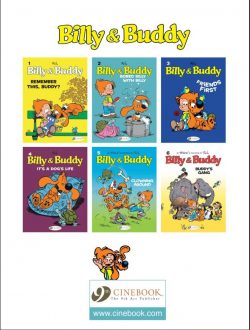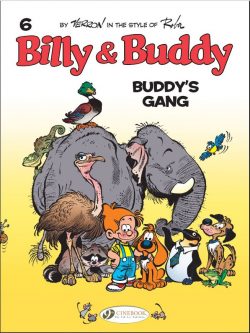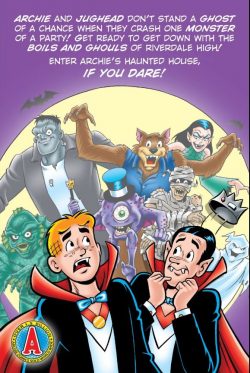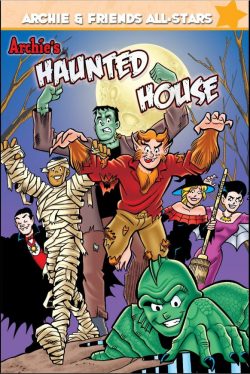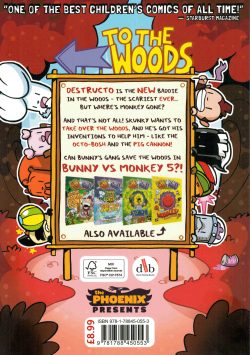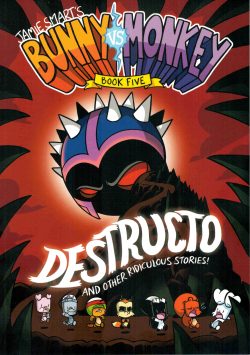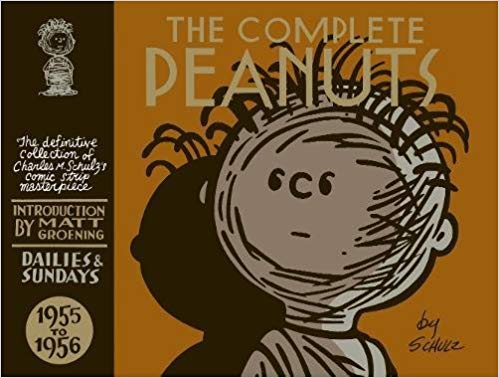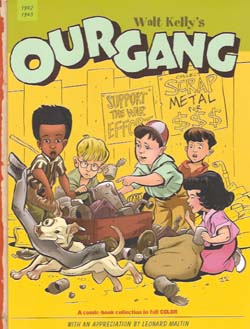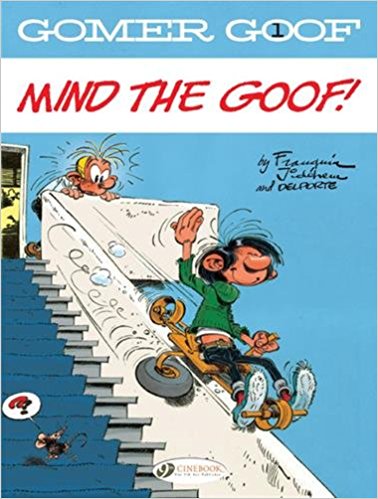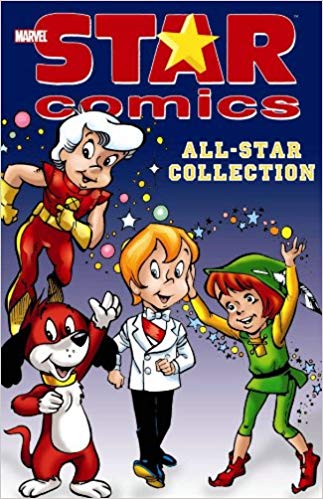
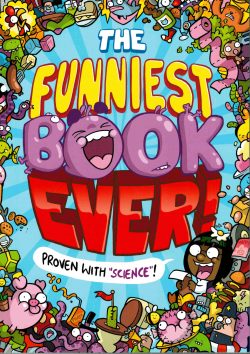
By Jaimie Smart, James Turner, Laura Ellen Anderson, Jess Bradley, Gary Northfield, James Stayte & various (David Fickling Books)
ISBN: 978-1-78845-013-3
Win’s Christmas Gift Recommendation: Silly, Sensational, Unmissable… 9/10
Nearly Christmas Again! Soon the kids will be on holiday and perpetually underfoot. Moreover, parents and extended family will be looking for presents they can afford and actually comprehend.
What about a book? A really, Really Funny Book?
Very much in the manner of classic Christmas Annuals, The Funniest Book Ever! is another wonderful compendium of captivating comics from the fabulous weekly Phoenix, designed to incapacitate your unruly young ‘uns with cartoon japery and adventure. Moreover, as it proudly boasts on the cover it’s all done with SCIENCE! So, it’s even scholastically advantageous.
Since its premiere in 2012, The Phoenix has offered humour, adventure, quizzes, puzzles and educational material in a traditional-seeming weekly comics anthology for girls and boys. The vibrant parade of fun and fantasy has won praise from the Great and the Good, child literacy experts and the only people who really count – a dedicated and growing legion of totally engaged kids and parents who read it avidly…
Jam-packed within these glossy, full-colour pages are more exploits culled from the periodical pages, starring a pantheon of firm favourites, all curated by a team of junior boffins endeavouring to ascertain and confirm their theory that the universe is held together by fundamental forces best described as “The Seven Laughsâ€â€¦
Acting as a proof of each are seven of the magazine’s most memorable features, as the highly technical treatise begins with Belly Rumble, an argument defined here by more arcadian action from twin stars locked in a spiralling orbit of mutually assured distraction as the execute an ongoing vendetta between implacable woodland warriors…
Concocted with feverishly glee by Jamie Smart, Bunny vs. Monkey has been a Phoenix fixture from the first issue: recounting a madcap war of nerves and ideologies between animal arch-enemies set amidst an idyllic arcadia which masquerades as a more-or-less mundane English Wood.
The tail-biting tension and rural war of wits and wonder-weapons began when an obnoxious simian intruder popped up after a disastrous space shot went awry. Having crash-landed in Crinkle Woods – a scant few miles from his blast-off site – Monkey believes himself the rightful owner of a strange new world, despite the continual efforts of sensibly reasonable Bunny to convince him otherwise.
For all his patience, propriety and poise, the laid-back long-ears simply cannot contain the incorrigible idiot ape, who is a rude, noise-loving, chaos-creating troublemaker. Things soon escalated once the simian interloper teamed up with an utterly mad scientist skunk who is master of many malign sciences and technologies…
In this tranche of turbulent tiny terrors Monkey manifests mayhem and endures great pain after declaring ‘Down with Spring’ before weaponizing Angling in a ‘Fish Off’ with Bunny and abusing history with a wooden Trojan trap in ‘There’s a Moose Loose!’
‘Leaf it Alone!’ finds the hyperactive simian turning simple garden chores into a mini-apocalypse whilst his on-going partnership with the skunk leads to an invisible bovine in the snows. However, their ‘Ca-Moo-Flaaj’ is as nothing compared to Bunny’s natural advantages…
After perverting a simple carrot with chemistry, Skunky anticipates ‘The Biggest, Mostest Enormousest Explosion in the World!’ but has not reckoned on sometime guinea pig Action Beaver‘s unique appetites. A true contender for that honour arrives when Humanz chase astoundingly gifted birds into the woods and barely escape ‘The Kakapo Poo Kaboom!’ with their lives…
Even so, the nosy bipedal interlopers stick around causing problems until the critters unite to remove them using ‘A Bear Bum!’…
A hunt for ‘Worms!’ then leads to a cacophonous din after which a dragon incursion leads to a need for knight service in ‘Arise, Lord Wuffywuff!’
The abrupt menacing return of ‘Skunky!’ only provides disappointment and confusion, but his crazed influence remains once he unleashes his devastating, colossal De-Forester 9000, resulting in the unthinkable as Bunny and Monkey declare ‘The Truce!’ that leads to the mega-munching machine’s demise.
By the time Action Beaver becomes ‘The Messenger!’ for Skunky’s poison letters, all bets are off again and it’s every critter for himself, leading to a doomed summit meeting at a hot spring in ‘Time to Get Along!’
The sinister scientist then proves you can have too much of a good thing after his Multiplyer accidentally creates a tidal wave of ‘Doughnuts!’ before a special event proclaims ‘An Exclusive Bunny Vs Monkey Detective Story: The Curious Case of the Pig in the Night Time’ with our entire outré cast going through their Sherlock Holmesian motions…
‘The Order of the Moose!’ is a secret woodland society sworn to protect nature at all costs and after we see them spectacularly underperform this section concludes with Monkey and Skunky testing their nine-megaton ‘Explosive Sweets!’…
The next component of the larger debate is the Cosmic Chuckle and that means a heaping helping of Star Cat: one of the wildest rides in the wondrous weekly anthology as crafted by the astoundingly clever James Turner (Super Animal Adventure Squad, The Unfeasible Adventures of Beaver and Steve).
The strip began in issue #0 and has been synchronising orbits irregularly ever since…
The premise is timeless and instantly engaging, revealing the far-out endeavours of a bunch of spacefaring nincompoops in the classic mock-heroic manner. There’s so very far-from-dauntless Captain Spaceington, extremely dim amoeboid Science Officer Plixx, inarticulate and barely housebroken beastie The Pilot and Robot One, who quite arrogantly and erroneously believes himself one of the smartest thinkers in the cosmos.
The colossal, formidable void-busting vessel they traverse the universe in looks like a gigantic ginger tom because that is what it is: half-cat, half-spaceship. What more do you need to know?
Hypothesised here are a brace of extended exploits beginning with ‘Just Deserts’ as the intrepid band crash on to super Saharan sand world and suffer the agonies of the damned – sort of – before ‘Computational Capers’ finds them back in space and battling a tyrannical computer with ideas above his (work) station…
Evil Cackle cites Evil Emperor Penguin as proof of concept. The strip was conceived and created by children’s book illustrator/author Laura Ellen Anderson (Kittens, Snow Babies) and stars a bad – brilliant but Bad – bird who lurks in a colossal fortress beneath the Antarctic, where he strives tirelessly towards his stated goal of absolute global domination.
His only assistance – if you can call it that – comes in the form of an army of hench-minions: most notably stylish, erudite administrative lackey Number 8 and cute, diminutive, fuzzy, loyal, utterly inventive abominable snowman clone Eugene.
Evil Emperor Penguin had originally whipped up a batch of 250, but none of the others are anything like Eugene…
EEP then appointed the fluffy, bizarrely inventive tyke his Top Minion but somehow never managed to instil within him the proper degree of ruthless evilness. The hairy halfwit is, however, a dab-hand with engineering, building stuff and cooking spaghetti hoops, so it’s not a total loss…
The polar pirate starts this particular campaign of terror by attempting to crash a sporty party for the world’s top brass in ‘Human Nature’ parts I & 2. To assist his gatecrashing the Annual World Leader Olympics, the bad bird has to wear a human-shaped robot suit and that’s never a good thing, is it?
Everybody loves cute kittens, which is what Debra is counting on when she uses soppy Eugene to infiltrate the fortress and steal all the Spaghetti Hoops in ‘What’s New Pussy Cat’. She’s the cousin of Evil Cat (EEP’s insidious rival in the Word Domination stakes) and with the team – and even Evil Cat – helplessly trapped, they must all surrender all pride and dignity and call on jolly unicorn Keith to save them in ‘Rainbows to the Rescue’…
The nefarious nonsense recommences with 2-part thriller-chiller ‘I Will Crèche You’ wherein EEP’s incredible De-Agefying Youth Juice causes havoc after Evil Cat breaks into the citadel and everybody gets a rejuvenating soaking…
The ice escapades conclude with ‘Eugene’s Day Off’: an unremitting stream of great experiences for the faithful servitor, but, for the Penguin Potentate – having to make do with substandard substitute Neill – a string of catastrophic, humiliating and painful disasters…
Wild Card calculation Squid Fits leads us inexorably to Jess Bradley’s diverting digressions Squid Bits! A proof of Laugh #4: that features gags, absurd Things To Do and odd innovations ranging from Monster Fashion to Red Panda’s Insult Guide and Cut ‘n’ Keep Characters to Official Words for Everyday Sounds!
These Fishy fascinations precede the arrival of next stellar party particle star turn as Critter Titter invites a closer inspection of Gary’s Garden.
This marvellous minibeast comedy-adventure is crafted by Gary Northfield (Beano‘s Derek the Sheep, The Terrible Tales of the Teeytinysaurs) and explores human nature through the fauna and flora unnoticed at our feet.
Human laggard Gary, like most of us, doesn’t do as much as he should in his back yard – and the assorted birds, beasts and bugs despise him for it – but at least it means they can all live their lives in relative peace and quiet…
The occasional series began in The Phoenix #2, and this seditious sampling opens with an army of brassed-off birds raiding the lazy lump’s kitchen cupboards, after which nocturnal raiders reveal the basics of bin-raiding whilst at the treeline an ambitious bug steals a golden acorn and dissolves into ego mania as a six-limbed Sith lord…
As Larry Ladybird hunts for his beloved Elaine and dreads her elopement with Dracula, in the pond a tadpole is daydreaming with amazing consequences and an art class is being disrupted by a most intransigent slug.
When Stunt Slug‘s attention-grabbing scheme goes awry, a motley band of beasts, birds and bugs occupy themselves by entering the Great Garden Bake Off – in a festive extra-long episode before the examples end with the debut of a chitinous band of merrie “men†and a new Ladybird Robin Hood…
Barbarian Celebrity Chef Gorebrah! crushes evil whilst concocting outrageous recipes and tasty treats so he’s the ideal exemplar of the Gastronomic Guffaw: offering a selection of dishes and disasters including prehistoric demonic biscuits embedded in glacial ice, princess-flavoured milkshakes, monopolised by cloud-dwelling giants, smoky sausage bats and a duel with a rival gustatory wild man.
Later mirth -&-mayhem packed menus include the gnomish origins of pasta salad and the creepiest dish in the world, saved from an alien invader deep inside an Antarctic culinary school…
Th scientific arguments crash to a halt with the Uncontrollable Giggle as Looshkin – the Adventures of the Maddest Cat in the World!! – seals the thesis with a sleek sheen of feline frenzy and surreal Shock and Awe.
Devised by Jamie Smart (yeah, the guy who invented Bunny vs. Monkey, Corporate Skull and bunches of other brilliant strips for Beano, Dandy and others) this is a brilliantly bonkers addition to the vast feline pantheon of truly horrifying hairballs infesting the graphic universe.
This anarchic kitty is just like yours: cute, innocently malign and able to twist the bounds of credibility and laws of physics whenever the whim takes him…
Quite naturally, the epic begins with an origin of sorts as Mrs Alice Johnson brings home a kitten from the pet shop. Not one of the adorable little beauties at the front of the store, though, but the odd, creepy, lonely little fuzzy hidden at the back of the store…
The Johnsons are not your average family. Firstborn son Edwin watches too many horror films and keeps a book of spells in his room whilst Dad is a brilliant inventor who needs peace and quiet to complete his fart-powered jet-pack or potato-powered tractor. It’s not long before those days are gone for good…
The sweet little daughter isn’t all she seems either: when kitten Looshkin is subjected to an innocent tea party in the garden, her toys all secretly warn the cat of the horrors in store. All too soon teddy bear Bear is subjected to a hideous cake-arson assault.
Surprisingly, Looshkin takes it all in stride and even escalates the carnage and chaos whenever and however he can. It seems he has found his natural home… or is it all in his be-whiskered little head?
The selection opens with ‘How to Make Friends and Annoy Bears’ as the cat’s nocturnal pranks result in cacophonous calamity after which ‘ThbthbtThhhhhhhhhhhHonk!’ reveals the lengths some folk will go to in executing the perfect raspberry…
‘Danger Sausage’ might not be everyone’s ideal superhero but Looshkin thinks he’s the business, after which a frog glove-puppet claims ‘I’m Not to Blame’ when a bulldozer destroys the garden…
‘Wooooooo – cough – oooooooh!!’ proves that even ghosts know when they’re outclassed in the scaring stakes after which ‘Meanwhile in Croydon’ finds the frenetic feline getting a job in marketing and ‘Nee-Naw! Nee-Naw! Nee-Naw! Neeeee-Nawww!’ sees the transition to a nursing career after almost fatally injuring Mr. Johnson.
Science then goes Boink! and reality gets temporarily inverted with the mind-bending ‘Big Silly Blue Cat Who Are You and What are you Doing in my House? before consistency, if not normality, are restored in ‘With Great Power Comes Giant Lasers’ as a certain cat becomes US president and leader of the Free World. Don’t scoff; stranger things have happened…
‘Due to an Incident involving Angry Clowns There Now Follows a Change in our Usual Programming’ see the madcap mouser drawn into the mesmerising power of old sitcoms whilst ‘Doorbell Ding Dong!!’ opens a war of postal one-upmanship between cat and Bear…
The brain-blasting advent of the cat’s mercurial Great Uncle Olaf begins with ‘Loooshkin! Oh Looshkin, Where Are You? You’ve Been Missing for Ages’ but is soon sidelined when Edwin’s magical library is used to call up something dreadful by ‘The Lump Whisperer’…
When Looshkin indulges in some prognostication the outcome is never in doubt especially for ‘Pig!’, but the cat is back on terrifying form in ‘Ooooh!! I’m Bustin’!’ when an outbreak of gastric unhappiness coincides with the sudden sabotage of every toilet in town…
There’s a big surprise for all concerned when Looshkin invents a vicious new game in ‘A New Challenger Appears!’ before everything wraps up in seasonal spirit with a bizarre trip to the twilight zone of yule tide with ‘A Christmas Special!!’
Arguments thus presented, (see what I did there?) this bonanza tome – packed with fun, thrills and the type of bizarre, nonsensical wonderment kids love but can’t explain to anyone over 21 – leaves it to you to judge the veracity of the science. That’s best done by reading and rereading The Funniest Book Ever: a superb package of British-style children’s humour and adventure any parent should be proud to own. Christmas is Saved!
Text and illustrations © 2018 Jaimie Smart, James Turner, Laura Ellen Anderson, Jess Bradley, Gary Northfield, James Stayte as appropriate. All rights reserved.
